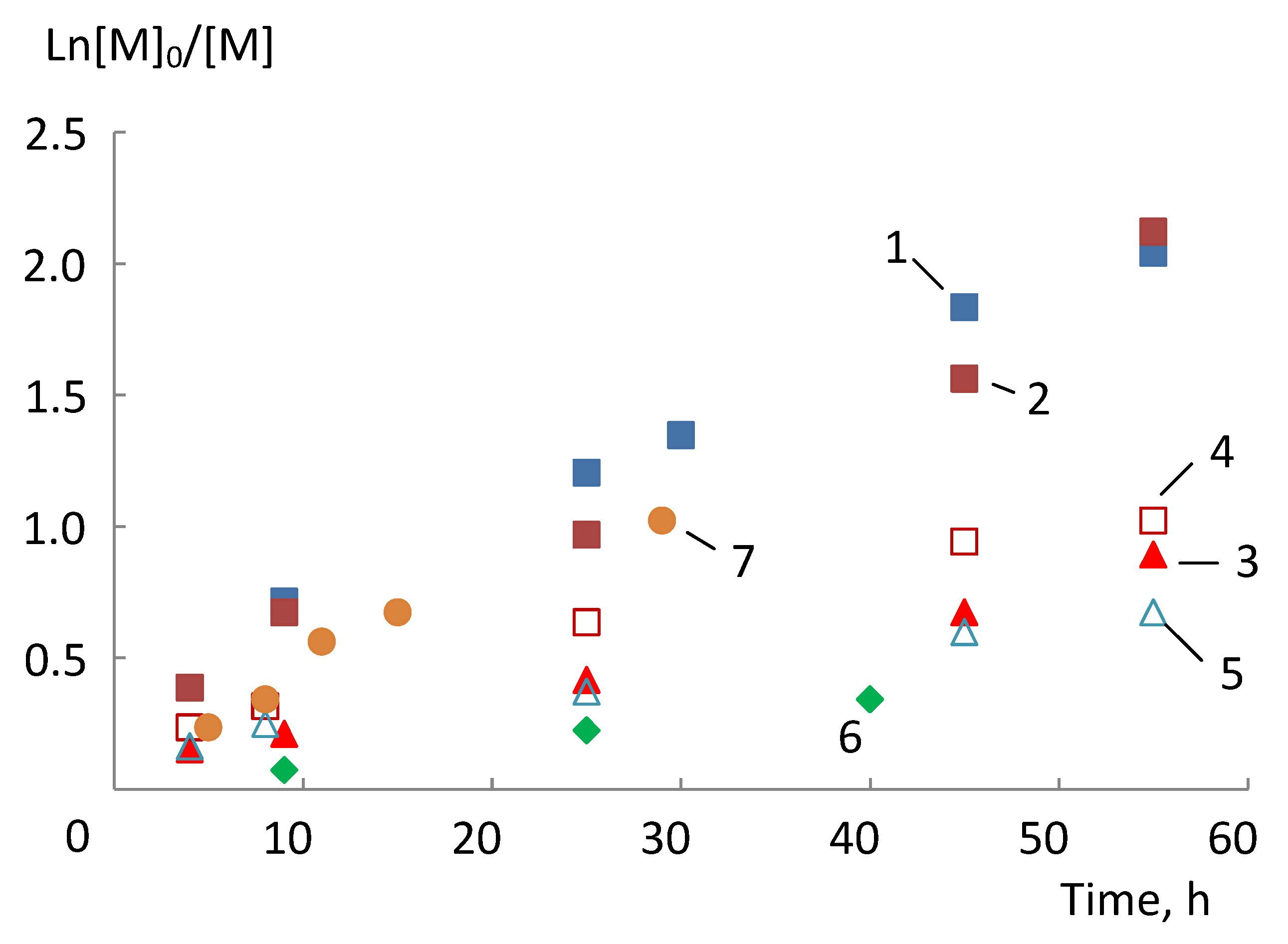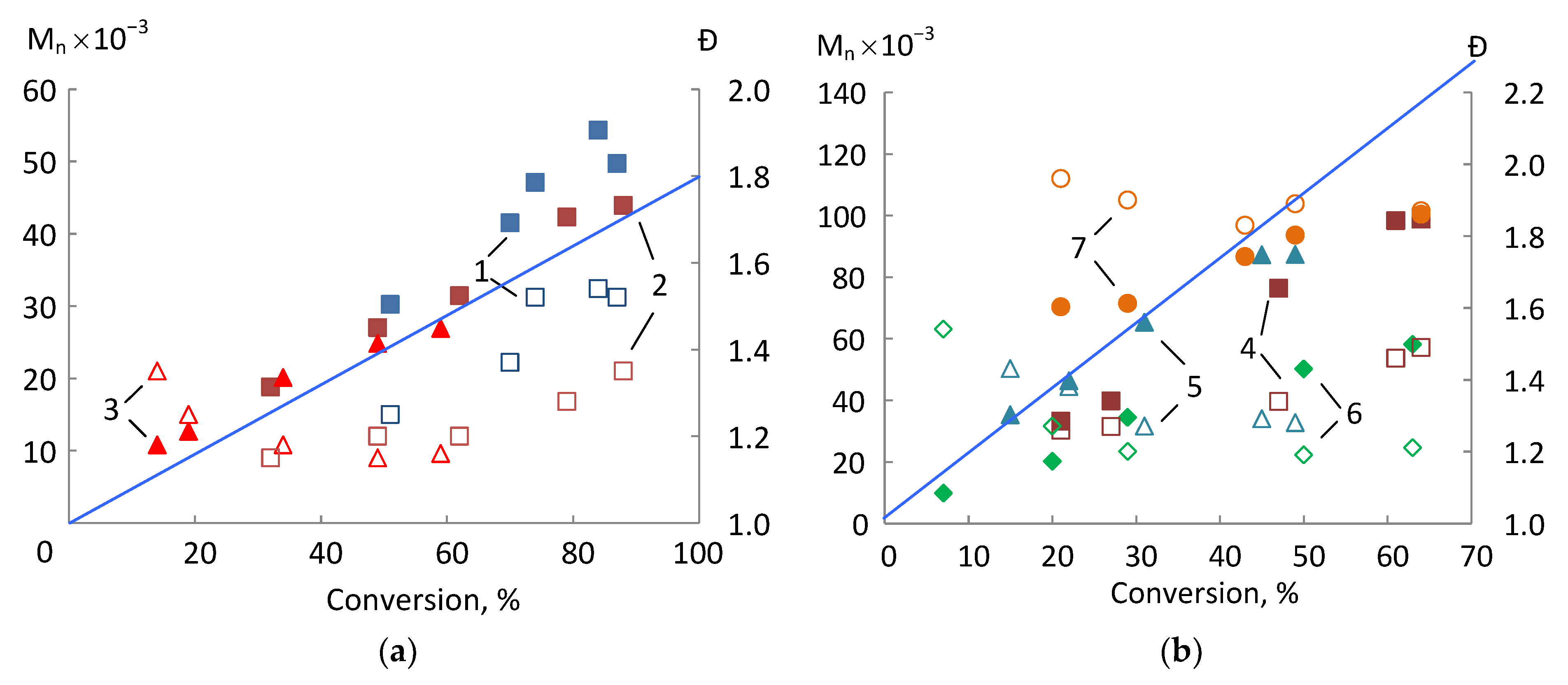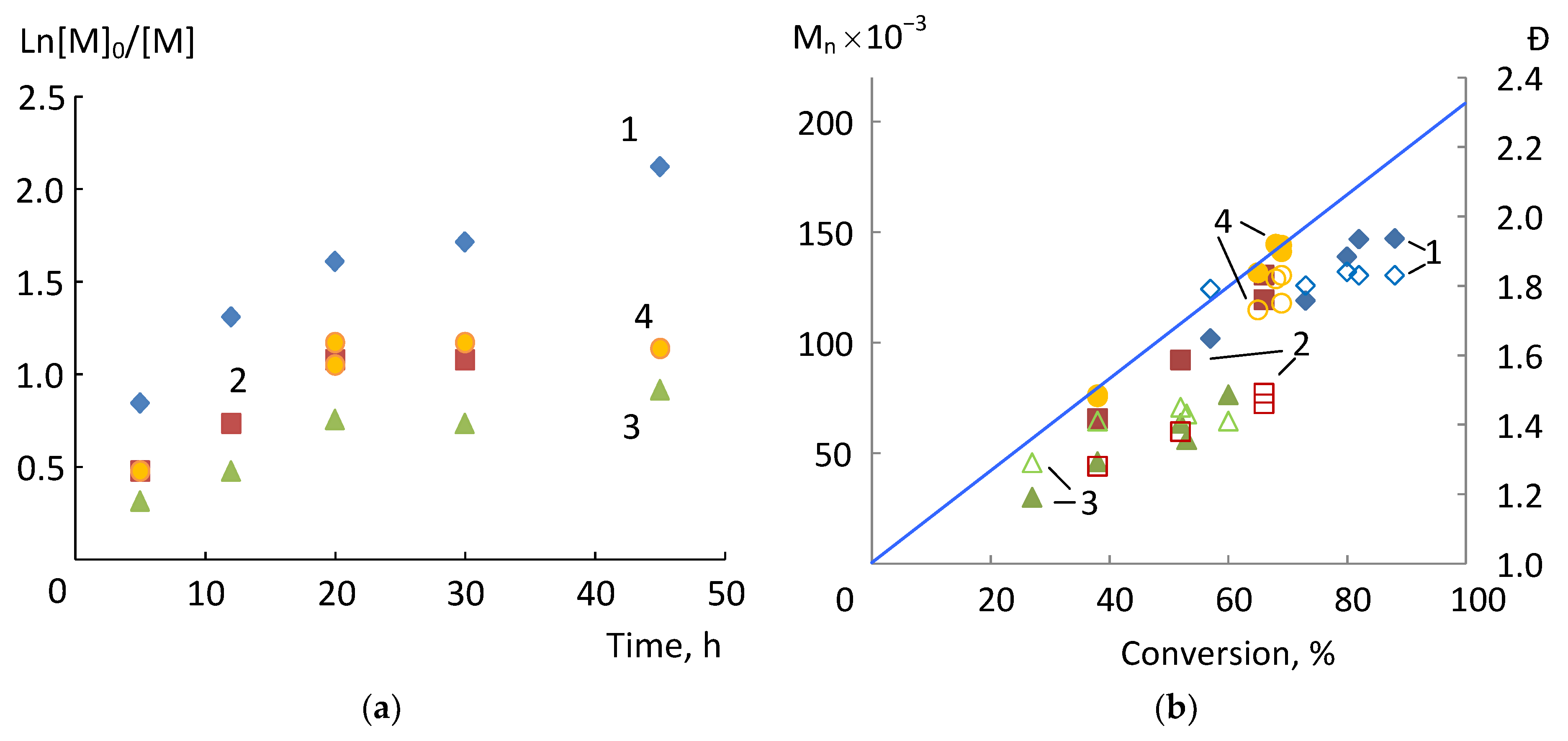Novel Copper-Based Catalytic Systems for Atom Transfer Radical Polymerization of Acrylonitrile
Abstract
1. Introduction
2. Results
2.1. Rochelle Salt as a Reducing Agent for AGET ATRP of Acrylonitrile
2.2. Tandem Catalysis by Two Copper Complexes
2.3. UV-VIS Study of Cu(II) Reduction by Roshelle Salt
2.4. Electrochemical Studies of Copper-Based Catalytic Systems
3. Discussion
4. Materials and Methods
4.1. General Considerations
4.2. Polymerization Procedure
4.3. Polymer Characterization
4.4. UV-VIS Spectrometry
4.5. Cyclic Voltammetry
Author Contributions
Funding
Data Availability Statement
Conflicts of Interest
References
- Corrigan, N.; Jung, K.; Moad, G.; Hawker, C.J.; Matyjaszewski, K.; Boyer, C. Reversible-deactivation radical polymerization (Controlled/living radical polymerization): From discovery to materials design and applications. Progr. Polym. Sci. 2020, 111, 101311. [Google Scholar] [CrossRef]
- Zhou, Y.N.; Li, J.J.; Wang, T.T.; Wu, Y.Y.; Luo, Z.H. Precision polymer synthesis by controlled radical polymerization: Fusing the progress from polymer chemistry and reaction engineering. Progr. Polym. Sci. 2022, 130, 101555. [Google Scholar] [CrossRef]
- Dworakowska, S.; Lorandi, F.; Gorczyński, A.; Matyjaszewski, K. Toward Green Atom Transfer Radical Polymerization: Current Status and Future Challenges. Adv. Sci. 2022, 9, 2106076. [Google Scholar] [CrossRef] [PubMed]
- Grishin, I.D. New Approaches to Atom Transfer Radical Polymerization and Their Realization in the Synthesis of Functional Polymers and Hybrid Macromolecular Structures. Polym Sci. Ser. C 2022, 64, 106–119. [Google Scholar] [CrossRef]
- Messina, M.S.; Messina, K.M.M.; Bhattacharya, A.; Montgomery, H.R.; Maynarda, H.D. Preparation of biomolecule-polymer conjugates by grafting-from using ATRP, RAFT, or ROMP. Progr. Polym. Sci. 2020, 100, 101186. [Google Scholar] [CrossRef]
- Grishin, D.F.; Grishin, I.D. Modern trends in controlled synthesis of functional polymers: Fundamental aspects and practical applications. Russ. Chem. Rev. 2021, 90, 231–264. [Google Scholar] [CrossRef]
- Jakubowski, W.; Matyjaszewski, K. Activator Generated by Electron Transfer for Atom Transfer Radical Polymerization. Macromolecules 2005, 38, 4139–4146. [Google Scholar] [CrossRef]
- Yuan, M.; Cui, X.; Zhu, W.; Tang, H. Development of Environmentally Friendly Atom Transfer Radical Polymerization. Polymers 2020, 12, 1987. [Google Scholar] [CrossRef]
- Jakubowski, W.; Min, K.; Matyjaszewski, K. Activators Regenerated by Electron Transfer for Atom Transfer Radical Polymerization of Styrene. Macromolecules 2006, 39, 39–45. [Google Scholar] [CrossRef]
- Min, K.; Gao, H.; Matyjaszewski, K. Use of Ascorbic Acid as Reducing Agent for Synthesis of Well-Defined Polymers by ARGET ATRP. Macromolecules 2007, 40, 1789–1791. [Google Scholar] [CrossRef]
- Szczepaniak, G.; Fu, L.; Jafari, H.; Kapil, K.; Matyjaszewski, K. Making ATRP More Practical: Oxygen Tolerance. Acc. Chem. Res. 2021, 54, 1779–1790. [Google Scholar] [CrossRef] [PubMed]
- Szczepaniak, G.; Łagodzinska, M.; Dadashi-Silab, S.; Gorczynski, A.; Matyjaszewski, K. Fully oxygen-tolerant atom transfer radical polymerization triggered by sodium pyruvate. Acc. Chem. Res. 2021, 54, 1779–1790. [Google Scholar] [CrossRef] [PubMed]
- Howard, J.W.; Fraser, W.A. Pyruvic acid. A Publication of Reliable Methods for the Preparation of Organic Compounds. Org. Synth. 1925, 4, 63. [Google Scholar] [CrossRef]
- Lorandi, F.; Matyjaszewski, K. Why Do We Need More Active ATRP Catalysts? Isr. J. Chem. 2020, 60, 108–123. [Google Scholar] [CrossRef]
- Matyjaszewski, K. Advanced Materials by Atom Transfer Radical Polymerization. Adv. Mater. 2018, 30, 1706441. [Google Scholar] [CrossRef]
- Ribelli, T.G.; Fantin, M.; Daran, J.-C.; Augustine, K.F.; Poli, R.; Matyjaszewski, K. Synthesis and Characterization of the Most Active Copper ATRP Catalyst Based on Tris[(4-dimethylaminopyridyl)methyl]amine. J. Am. Chem. Soc. 2018, 140, 1525–1534. [Google Scholar] [CrossRef]
- Tang, W.; Tsarevsky, N.V.; Matyjaszewski, K. Determination of Equilibrium Constants for Atom Transfer Radical Polymerization. J. Am. Chem. Soc. 2006, 128, 1598–1604. [Google Scholar] [CrossRef]
- Stakhi, S.A.; Grishin, D.F.; Grishin, I.D. Tandem catalysis of Atom Transfer Radical Polymerization of acrylonitrile based on simultaneous use of two copper complexes. J. Polym. Res. 2021, 28, 457. [Google Scholar] [CrossRef]
- Cai, J.Y.; McDonnell, J.; Brackley, C.; O’Brien, L.; Church, J.S.; Millington, K.; Smith, S.; Phair-Sorensen, N. Polyacrylonitrile-based precursors and carbon fibers derived from advanced RAFT technology and conventional methods—The 1st comparative study. Mat. Today Comm. 2016, 9, 22–29. [Google Scholar] [CrossRef]
- Nanda, A.K.; Matyjaszewski, K. Effect of [PMDETA]/[Cu(I)] Ratio, Monomer, Solvent, Counterion, Ligand, and Alkyl Bromide on the Activation Rate Constants in Atom Transfer Radical Polymerization. Macromolecules 2003, 36, 1487–1493. [Google Scholar] [CrossRef]
- Tang, W.; Kwak, Y.; Braunecker, W.; Tsarevsky, N.V.; Coote, M.L.; Matyjaszewski, K. Understanding Atom Transfer Radical Polymerization: Effect of Ligand and Initiator Structures on the Equilibrium Constants. J. Am. Chem. Soc. 2008, 130, 10702–10713. [Google Scholar] [CrossRef]
- Vorotyntsev, M.A.; Casalta, M.; Pousson, E.; Roullier, L.; Boni, G.; Moise, C. Redox properties of titanocene-pyrrole derivative and its electropolymerization. Electrochim. Acta 2001, 46, 4017–4033. [Google Scholar] [CrossRef]
- Fenton, H.J.H. LXXIII.-Oxidation of Tartaric Acid in presence of Iron. J. Chem. Soc. Trans. 1894, 65, 899–910. [Google Scholar] [CrossRef]
- Brose, D.A.; James, B.R. Hexavalent Chromium Reduction by Tartaric Acid and Isopropyl Alcohol in Mid-Atlantic Soils and the Role of Mn(III,IV)(hydr)oxides. Environ. Sci. Technol. 2013, 47, 12985–12991. [Google Scholar] [CrossRef] [PubMed]
- Takashima, K.; Ziglio, C.M.; Ronconi, C.M. Kinetic and mechanistic aspects for the tartaric acid oxidation by vanadium(V) in sulfuric acid medium. Int. J. Chem. Kin. 1998, 30, 55–61. [Google Scholar] [CrossRef]
- Kaizaki, S.; Nakahanada, M.; Fuyuhiro, A.; Ikedo-Urade, M.; Abe, Y. Synthesis, characterization and redox reactivity of L-tartrato bridged dinuclear manganese complex with 2,2-bipyridine. Inorg. Chim. Acta 2009, 362, 5117–5121. [Google Scholar] [CrossRef]
- Sahu, S.; Padhy, R.K.; Nanda, S.P. Surfactant catalyzed electron transfer mechanism in the oxidation of racemic tartaric acid by Ce(IV). Mater. Today Proc. 2022. [Google Scholar] [CrossRef]
- Cai, Z.Y.; Pei, L.Z.; Yang, Y.; Pei, Y.Q.; Fan, C.G.; Fu, D.G. Electrochemical behavior of tartaric acid at CuGeO3 nanowire modified glassy carbon electrode. J. Solid State Electrochem. 2012, 16, 2243–2249. [Google Scholar] [CrossRef]
- Liu, X.-H.; Zhang, G.-B.; Li, B.-X.; Bai, Y.-G.; Li, Y.-S. Copper(0)-mediated living radical polymerization of acrylonitrile: SET-LRP or AGET-ATRP. J. Polym Sci. Part A: Polym. Chem. 2010, 48, 5439–5445. [Google Scholar] [CrossRef]
- Zhang, C.; Ling, J.; Wang, Q. Radical Addition-Coupling Polymerization (RACP) toward Periodic Copolymers. Macromolecules 2011, 44, 8739–8743. [Google Scholar] [CrossRef]
- Liu, X.; Wang, J.; Yang, J.; An, S.; Ren, Y.; Yu, Y.; Chen, P. Fast copper catalyzed living radical polymerization of acrylonitrile utilizing a high concentration of radical initiator. J. Polym Sci. Part A: Polym. Chem. 2012, 50, 1933–1940. [Google Scholar] [CrossRef]






| Initiator | Conversion, % | Mn × 10−3 | Đ | Mn, Theor |
|---|---|---|---|---|
| 2FBiB | 80 | 54.5 | 1.89 | 38.7 |
| Ethyl-2-bromoisobutyrate | 67 | 45.4 | 1.59 | 32.4 |
| Diethyl-2-bromo-2-methylmalonate | 81 | 39.5 | 1.57 | 39.1 |
| CCl4 | 65 | 28.8 | 1.43 | 31.4 |
Disclaimer/Publisher’s Note: The statements, opinions and data contained in all publications are solely those of the individual author(s) and contributor(s) and not of MDPI and/or the editor(s). MDPI and/or the editor(s) disclaim responsibility for any injury to people or property resulting from any ideas, methods, instructions or products referred to in the content. |
© 2023 by the authors. Licensee MDPI, Basel, Switzerland. This article is an open access article distributed under the terms and conditions of the Creative Commons Attribution (CC BY) license (https://creativecommons.org/licenses/by/4.0/).
Share and Cite
Grishin, I.D.; Zueva, E.I.; Pronina, Y.S.; Grishin, D.F. Novel Copper-Based Catalytic Systems for Atom Transfer Radical Polymerization of Acrylonitrile. Catalysts 2023, 13, 444. https://doi.org/10.3390/catal13020444
Grishin ID, Zueva EI, Pronina YS, Grishin DF. Novel Copper-Based Catalytic Systems for Atom Transfer Radical Polymerization of Acrylonitrile. Catalysts. 2023; 13(2):444. https://doi.org/10.3390/catal13020444
Chicago/Turabian StyleGrishin, Ivan D., Elizaveta I. Zueva, Yulia S. Pronina, and Dmitry F. Grishin. 2023. "Novel Copper-Based Catalytic Systems for Atom Transfer Radical Polymerization of Acrylonitrile" Catalysts 13, no. 2: 444. https://doi.org/10.3390/catal13020444
APA StyleGrishin, I. D., Zueva, E. I., Pronina, Y. S., & Grishin, D. F. (2023). Novel Copper-Based Catalytic Systems for Atom Transfer Radical Polymerization of Acrylonitrile. Catalysts, 13(2), 444. https://doi.org/10.3390/catal13020444






